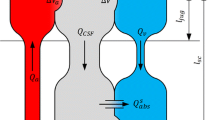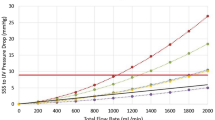Abstract
The role of the cerebral venous bed in the cranial volume-pressure test was examined by means of a mathematical model. The cerebral vascular bed was represented by a single arterial compartment and two venous compartments in series. The lumped-parameter formulation for the vascular compartments was derived from a one-dimensional theory of flow in collapsible tubes. It was assumed in the model that the cranial volume is constant. The results show that most of the additional volume of cerebrospinal fluid (ΔVCSF) was accommodated by collapse of the cerebral venous bed. This profoundly altered the venous haemodynamics and was reflected in the cranial pressure PCSF. The cranial volume-pressure curve obtained from the model was consistent with experimental data; the curve was flat for 0<-ΔVCSF<-20 ml and 35<-ΔVCSF<-40 ml, and steep for 20<-ΔVCSF<-35 ml and ΔVCSF>-40 ml. For ΔVCSF>25 ml and PCSF>5.3 kPa (40 mmHg), cerebral blood flow dropped. When PCSF was greater than the mean arterial pressure, all the veins collapsed. The conclusion of the study was that the shape of the cranial volume-pressure curve can be explained by changes in the venous bed caused by various degrees of collapse and/or distension.
Similar content being viewed by others
References
Attinger, E. O. (1964): ‘The cardiovascular system’, inAttinger, E. O. (Ed.): ‘Pulsatile blood flow’ (McGraw-Hill, 1964), pp. 1–14
Auer, L. M., andMcKenzie, E. T. (1984): ‘Physiology of the cerebral venous system’, inKapp, J. P., andSchmidek, H. H. (Eds): ‘The cerebral venous system and its disorders’ (Grune & Stratton Inc., 1984), pp. 169–227
Bosnjak, R., andKordas, M. (2002): ‘Circulatory effects of internal jugular vein compression: a computer simulation study’,Med. Biol. Eng. Comput.,40, pp. 423–431
Brook, B. (1997): ‘The effect of gravity on the haemodynamics of the giraffe jugular vein’. PhD thesis, University of Leeds, UK
Chopp, M., Portnoy, H. D., andBranch, M. S. (1983): ‘Hydraulic model of the cerebrovascular bed. Understanding the volumepressure test’Neurosurg.,13, pp. 5–11
Cirovic, S., Walsh, C., andFraser, W. D. (2000): ‘A mathematical model of cerebral perfusion subjected to Gz acceleration’,Aviat. Space Environ. Med.,71, pp. 514–521
Cirovic, S., Walsh, C., andFraser, W. D. (2001): ‘A mechanical model of cerebral circulation during sustained acceleration’,Aviat. Space Environ. Med.,72, pp. 704–712
Collins, R., andMaccario, J. A. (1979): ‘Blood flow in the lung’,J. Biomech.,12, pp. 373–395
Constantinesku, V. N. (1995): ‘Steady parallel flow of incompressible fluids’ in ‘Laminar viscous flow’ (Springer, 1995), pp. 110–137
Ekstedt, J. (1978): ‘CSF hydrodynamic studies in man: 2 Normal hydrodynamic variables related to CSF pressure and flow’,J. Neurol. Neurosurg. Psychiat.,41, pp. 345–353
Fung, Y. C. (1996): ‘Blood flow in arteries’ in ‘Biodynamics: Circulation’ (W.B. Springer Verlag, 1996), pp. 77–157
Guyton, A. C., andHall, J. E. (1996): ‘The circulation’, in ‘Textbook of medical physiology’ (W.B. Saunders Company, 1996), pp. 161–293
Hamilton, W. F., Woodbury, R. A., andHarper, H. T. (1943): ‘Arterial cerebrospinal and venous pressures in man during cough and strain’,Am. J. Physiol.,141, pp. 42–50
Kamm, R. D., andPedley, T. J. (1989): ‘Flow in collapsible tubes: A brief review’,J. Biomech. Eng.,111, pp. 117–179
Ladurner, M., andAuer, L. M. (1984): ‘Alterations of the cerebral blood volume’, inKapp, J. P., andSchmidek, H. H. (Eds): ‘The cerebral venous system and its disorders’ (Grune & Stratton Inc., 1984), pp. 229–248
Langfitt, T. W., Kassel, N. F., andWeinstein, J. D. (1965): ‘Cerebral blood flow with intracranial hypertension’,Neurology,15, pp. 761–773
Luce, J. M., Huseby, J. S., Kirk, W., andButler, J. (1982): ‘A Starling resistor regulates cerebral venous outflow in dogs’,J. Appl. Physiol.,53, pp. 1496–1503
Marmarou, A., Shulman, K., andLaMorgese, J. (1975): ‘Compartmental analysis of compliance and outflow resistance of the cerebrospinal fluid system’,J. Neurosurg.,43, 523–534
Marmarou, A., Shulman, K., andRosende, R. M. (1978): ‘A nonlinear analysis of the cerebrospinal fluid system and intracranial pressure dynamics’,J. Neurosurg.,48, pp. 332–344
Miller, J. D., Stanek, A., andLangfitt, T. W. (1972): ‘Concepts of cerebral perfusion pressure and vascular compression during intracranial hypertension’,Prog. Brain Res.,35, pp. 411–432
Moreno, A. H., Katz, A. I., Gold, L. D., andReddy, R. V. (1970): ‘Mechanics of distension of dog veins and other very tin-walled tubular structures’,Circ. Res.,27, pp. 1069–1080
Nakagawa, Y., Tsuru, M., andYada, K. (1974): ‘Site and mechanism of compression of the venous system during experimental hypertension’,J. Neurosurg.,41, pp. 427–434
Pedley, T. J. (1980): ‘Propagation of the pressure pulse’, in ‘The fluid mechanics of large blood vessels’ (Cambridge University Press, 1980), pp. 73–125
Pedley, T. J., Brook, B. S., andSeymour, R. S. (1996): ‘Blood pressure and flow rate in giraffe jugular vein’,Phil. Trans. R. Soc. Lond.,352, pp. 855–866
Piechnik, S. K., Czosnyka, M., Richards, H. K., Whitfield, P. C., andPickard, J. D. (2001): ‘Cerebral venous blood outflow: A theoretical model based on laboratory simulation’,Neurosurg.,49, pp. 1214–1223
Portella, G., Cormio, M., andCiterio, G. (2002): ‘Continous cerebral compliance monitoring in severe head injury: its relationship with intracranial pressure and cerebral perfusion pressure’,Acta Neurochir.,81, pp. 173–175
Portnoy, H. D., andChopp, M. (1994): ‘Intracranial fluid dynamics: Interrelationship of CSF and vascular phenomena’,Pediatr. Neurosurg.,20, pp. 92–98
Press, W. H., Teulkolsky, S. A., Vetterling, W. T., andFlannery, B. P. (1996): ‘Root finding and nonlinear sets of equations’, in ‘Numerical recipes in Fortran: the art of scientific computation’ (Cambridge University Press, 1996), pp. 340–376
Pucher, R., Kato, Y., Mokry, M., andAuer, L. M. (1991): ‘Cerebrovascular response to changes of cerebral venous pressure and cerebrospinal fluid pressure’,Acta Neurochirurgica,109, pp. 52–56
Raisis, J. E., Kindt, G. W., McGillicuddy, J. E., andGiannnotta, S. L. (1979): ‘The effects of primary elevation of cerebral venous pressure on cerebral haemodynamics and intracranial pressure’,J. Surg. Res.,26, pp. 101–107
Rushmer, R. F., Beckman, E. L., andLee, D. (1947): ‘Protection of the cerebral circulation by the cerebrospinal fluid under the influence of radial acceleration’,Am. J. Physiol.,151, pp. 459–468
Rushmer, R. F. (1976): ‘Peripheral vascular control’, in ‘Cardiovascular dynamics’ (W.B. Saunders Company, 1976), pp. 132–161
Sano, H., Kawase, T., andToya, S. (1983): ‘The changes in the cerebral microcirculation during increased intracranial pressure’, inAuer, L. M., andLoew, F. (Eds): ‘The cerebral veins: an experimental and clinical update’ (Springer-Verlag, 1983), pp. 231–238
Schmidt, B., Klingelhofer, J., Schwarze, J. J., Sander, D., andWittich, I. (1997): ‘Noninvasive prediction of intracranial pressure curves using transcranial doppler ultrasonography and blood pressure curves’,Stroke,28, pp. 2465–2472
Seymour, K. S., Shenkin, H. A., andShmidt, C. F. (1948): ‘The effect of increased intracranial pressure on cerebral circulatory function in man’,J. Clin. Invest.,27, pp. 493–499
Shapiro, A. H. (1977): ‘Steady flow in collapsible tubes’,J. Biomech. Eng.,99, pp. 126–147
Shapiro, K., Marmarou, A., andShulman, K. (1980): ‘Characterization of clinical CSF dynamics and neural axis compliance using the pressure-volume index: I The normal pressure-volume index’,Ann. Neurol.,7, pp. 508–514
Sheng, C., Sarwal, S. N., Watts, K. C., andMarble, A. E. (1995): ‘Computational simulation of blood flow in human systemic circulation incorporating an external force field’,Med. Biol. Eng. Comput.,33, pp. 8–17
Shulman, K., andVerdier, G. (1967): ‘Cerebral vascular resistance changes in response to cerebrospinal fluid pressure’,Am. J. Physiol.,213, pp. 1084–1088
Sorek, S., Bear, J., andKarni, Z. (1989): ‘Resistances and compliances of a compartmental model of the cerebrovascular system’,Ann. Biomed. Eng.,17, pp. 1–12
Sullivan, H. G., andAllison, J. D. (1985): ‘Physiology of cerebrospinal fluid’, inWilkins, R., andRengachary, S. (Eds): ‘Neurosurgery’ (McGraw Hill, 1985), pp. 2125–2135
Takemae, T., Kosugi, Y., Ikebe, J., Kumangi, Y., Matsuyama, K., andSaito, K. (1987): ‘A simulation study of intracranial pressure increment using an electric circuit model of cerebral circulation’,IEEE Trans. Biomed. Eng.,34, pp. 958–969
Ursino, M. (1988a): ‘A mathematical study of human intracranial hydrodynamics. Part 1—The cerebrospinal fluid pressure’,Ann. Biomed. Eng.,16, pp. 379–401
Ursino, M. (1988b): ‘A mathematical study of human intracranial hydrodynamics. Part 2—Simulation of the clinical tests’,Ann. Biomed. Eng.,16, pp. 403–416
Ursino, M., andDi Giammarco, P. (1991): ‘A mathematical model of the relationship between cerebral blood volume and intracranial pressure changes: The generation of plateau waves’,Ann. Biomed. Eng.,19, pp. 15–42
Ursino, M., Iezzi, M., andStoccetti, N. (1995): ‘Intracranial pressure dynamics in patients with acute brain damage: A critical analysis with the aid of a mathematical model’,IEEE Trans. Biomed. Eng.,42, pp. 529–540
Wesley, R. L. R., Vaishnav, R. N., Fuchs, J. C. A., Patel, D. J., andGreenfield, J. C. Jr (1975): ‘Static linear and non-linear elastic properties of normal and arterialized venous tissue in dog and man’,Circ. Res.,37, pp. 509–520
Wiedeman, M. P. (1963): ‘Dimensions of blood vessels from distributing artery to collecting vein’,Circ. Res.,12, pp. 375–378
Yada, K., Nakagaw, Y., andTsuru, M. (1973): ‘Circulatory disturbance of the venous system during experimental intracranial hypertension’,J. Neurosurg.,39, pp. 723–729
Zagzoul, M., andMarc-Vergnes, J. P. (1986): ‘A global mathematical model of the cerebral circulation in man’,J. Biomech.,19, pp. 1015–1022
Author information
Authors and Affiliations
Corresponding author
Rights and permissions
About this article
Cite this article
Cirovic, S., Walsh, C. & Fraser, W.D. Mathematical study of the role of non-linear venous compliance in the cranial volume-pressure test. Med. Biol. Eng. Comput. 41, 579–588 (2003). https://doi.org/10.1007/BF02345321
Received:
Accepted:
Issue Date:
DOI: https://doi.org/10.1007/BF02345321




